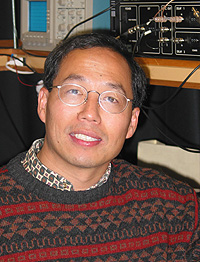Professor Jin Zhong Zhang
The PhysOrg article New nanostructured thin film shows promise for efficient solar energy conversion said
“In the race to make solar cells cheaper and more efficient, many researchers and start-up companies are betting on new designs that exploit nanostructures — materials engineered on the scale of a billionth of a meter. Using nanotechnology, researchers can experiment with and control how a material generates, captures, transports, and stores free electrons — properties that are important for the conversion of sunlight into electricity.Two nanotech methods for engineering solar cell materials have shown particular promise. One uses thin films of metal oxide nanoparticles, such as titanium dioxide, doped with other elements, such as nitrogen. Another strategy employs quantum dots — nanosize crystals — that strongly absorb visible light. These tiny semiconductors inject electrons into a metal oxide film, or ‘sensitize’ it, to increase solar energy conversion. Both doping and quantum dot sensitization extend the visible light absorption of the metal oxide materials.
Combining these two approaches appears to yield better solar cell materials than either one alone does, according to Jin Zhang, professor of chemistry at the University of California, Santa Cruz. Zhang led a team of researchers from California, Mexico, and China that created a thin film doped with nitrogen and sensitized with quantum dots. When tested, the new nanocomposite material performed better than predicted — as if the functioning of the whole material was greater than the sum of its two individual components.
‘We have discovered a new strategy that could be very useful for enhancing the photo response and conversion efficiency of solar cells based on nanomaterials,’ said Zhang.”
Jin Zhong Zhang, Ph.D., FAAAS is Professor of Chemistry, Faculty Graduate Advisor at the University of California, Santa Cruz. He is also Guest Professor, Northeast Normal University, Changchun, China and Senior Editor of the Journal of Physical Chemistry.
Jin’s research interests are experimental physical chemistry, materials chemistry, novel semiconductor, metal, and metal oxide nanomaterials, interfaces and nanoscience, solar energy conversion, hydrogen generation and storage, cancer biomarker detection using nanotechnology, femtosecond laser, and optical spectroscopy.
He is primarily interested in the design, development, characterization, and application of advanced materials with emphasis on optical and electronic nanomaterials of both semiconductors, metal oxides, and metals. These nanomaterials have novel physical and chemical properties due to quantum confinement and exceedingly large surface to volume ratio. The design and synthesis of the materials are mostly based on inorganic colloidal chemistry methods. The synthesized materials are characterized systematically and extensively using a variety of experimental techniques including optical spectroscopy (UV-visible, fluorescence, IR, and Raman), femtosecond laser spectroscopy (for probing ultrafast charge carrier dynamics), x-ray (XAFS, XRD, x-ray photoemission), electrochemical, and microscopy (HRTEM, SEM, AFM). In the meantime, he explores emerging technological applications of these advanced nanomaterials in areas such as solar energy conversion, hydrogen generation and storage, photocatalysis, photovoltaics, photoelectrochemistry, sensors and imaging (particularly based on SERS), detection of cancer biomarkers, solid state lighting, and lasers.
At the fundamental level, he hopes to elucidate, with molecular details, key factors, such as particle size, shape, crystal structure, interface, and environment, that influence the properties and functionalities of the nanomaterials. Femtosecond laser spectroscopy is used to directly probe of charge carrier or exciton dynamics on the ultrafast time scale. X-ray and high resolution microscopy allows for detailed structural studies. Optical and electronic properties are studied using optical spectroscopy and electrochemical measurements. One of his objectives is to establish relationship between the structure of the materials and their properties functionalities. At the technological level, he explores emerging applications of these novel materials in a number of areas including sensors, solar cells, hydrogen generation and storage, catalysis, detectors, imaging, solid state lighting, and lasers. Examples of nanomaterials systems that have been studied and/or are currently under investigation include: CdS, CdSe, CdTe, ZnS:Mn, ZnSe:Mn, ZnSe:Cu, ZnSe:Ag, AgI, AgBr, TiO2, ZnO, WO3, CuS, PbI2, PbS, Fe2O3, BiI3, Ag2S, Si, Ag, Pt, Pd, and Au.
In addition to nanomaterials, he is interested in photodrugs such as hematoporphyrin derivative, chlorins, and phthalocyanines that have been studied for possible application in photodynamic therapy (PDT). PDT is a novel medical technology for treatment of cancer tumors. PDT activity begins when the drug is exposed to light, which activates the drug and causes tumor destruction. PDT is selective and localized, and has less side effects compared to chemotherapy. Since the excited states of sensitizers are directly involved in the photoreaction process, a study of their excited state reaction mechanism is essential for achieving a good understanding of their function. This will help to accelerate the development of new and more efficient photodrugs. He is also interested in the study of interaction between photodrugs and protein as well as DNA molecules.
Jin coauthored Physical Chemistry of Interfaces and Nanomaterials, Ultrafast electron injection: Implications for a photoelectrochemical cell utilizing an anthocyanin dye-sensitized TiO2 nanocrystalline electrode, Nitrogen Doped and CdSe Quantum Dot Sensitized Nanocrystalline TiO2 Films for Solar Energy Conversion Applications, Molecular Probes Based on Microstructured Fibers and Surface Enhanced Raman Scattering, Gold nanotubes synthesized via magnetic alignment of cobalt nanoparticle templates, and The role of reductant oxidation state in the formation and function of gold nanoparticle aggregates for SERS applications. Read the full list of his publications!
Jin earned his B.Sc. with highest honors in Chemistry at Fudan University, Shanghai in 1983, and his Ph.D. at the University of Washington in 1989. In 2007 he was honored as a fellow of the American Association for the Advancement of Science (AAAS).
Read Hollow gold nanospheres show promise for biomedical and other applications.
